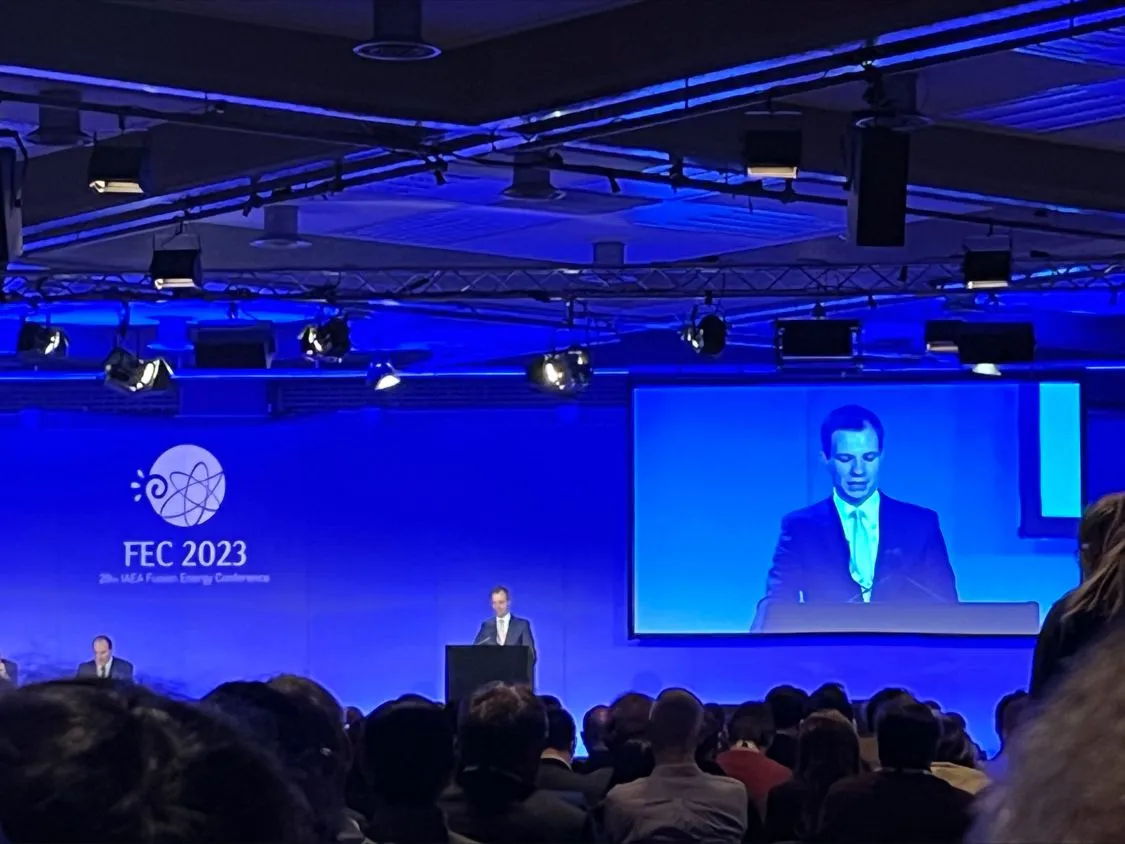New UK Fusion Strategy Announced
The UK Government released an updated strategy on fusion on Monday 16th of October. Announced by Andrew Bowie MP, Minister of Nuclear and Networks, this strategy is an update of the first fusion strategy published in 2021.
So, what have they done and why is it important?

Andrew Bowie MP at the IAEA Fusion Energy Conference
What have they done?
At the 29th IAEA Fusion Energy Conference, Minister Andrew Bowie and UKAEA CEO Sir Ian Chapman announced details and principles of a new, updated UK fusion strategy—Towards Fusion Energy 2023.
The strategy recognises that advances have been made since the first UK fusion strategy in October 2021, highlighting the National Ignition Facility achieving an energy gain, a new fusion energy record from the Joint European Torus, and the fact that over $6 billion has now been invested into private fusion companies.
They lay out a new “Fusion Futures Programme” for development of fusion in the UK. The three core areas of this programme are: Infrastructure; Skills; and Industrial and Commercial Opportunities. There is a focus on building the industry, building skills and on international collaboration.
Why is it impressive?
This new fusion strategy is released just 2 years after their first. It acknowledges the progress that has been made in the field and the government’s need to adapt.
Adam Baker, Head of Fusion Policy at DESNZ said, “We don’t want the UK government to stand still.”
Another impressive feature is the £650 million of additional investment that will go into fusion between 2023 and 2027. This is money that would have gone into Euratom but will now be redirected into the domestic fusion programme. You can read more about this in this previous blog.
Why is it important?
This strategy is focused on developing the fusion industry and is technology agnostic, so it aims to benefit the entire sector. In redirecting funds that would have gone to Euratom, the UK Government has tried to replicate the outcomes that would have come from being part of Euratom, namely R&D and developing the supply chain. The government is committed to fusion and wants to build up the industry to support it.
The UK fusion landscape is entering a period of great change. The JET tokamak is shutting down, the Spherical Tokamak for Energy Production (STEP) is advancing, the UK recently left Euratom, and the challenges of fusion are transitioning from scientific to engineering, industry, and regulatory challenges.
With this changing fusion landscape in the UK, it is encouraging to see the UK government changing with it.
This strategy aims to benefit the entire sector. While there is a real focus on magnetic confinement at UKAEA (with the JET and MAST tokamaks in operation and work ramping up in preparation for STEP), the strategy document states the intention to make inertial fusion an emphasis in more international collaborations in the future.
Minister Bowie, in his announcement, also talked about building new premises for fusion companies, and their aspiration to have the highest concentration of them in the world at Culham.
There will be investment in a new facility for research and innovation in fusion fuels and fuel cycle testing—again making it relevant for all technologies, not just tokamaks.

Culham Science Centre, owned and managed by the United Kingdom Atomic Energy Authority © Culham Science Centre
The new strategy allocates up to £35 million additional funding for the Fusion Industry Programme (FIP), a challenge fund supporting UK companies to develop new technologies.
The strategy also highlights regulation as a key area of development to facilitate the growth of the fusion industry. The UK government is working internationally with the Agile Nations Fusion Energy Working Group to create recommendations for fusion energy regulation. Moreover, a bill to regulate fusion plants not as nuclear instillations is expected to become law in the UK in 2024.
There will be an ambitious skills programme (still to be developed in consultation with the sector) aiming to build the fusion workforce broadly, aiming at every career level and over a variety of skills. Up to £55 million has been pledged to train over 2,200 people over the next 5 years.

Andrew Bowie MP
What’s next?
The next step for this strategy is finalisation and implementation. There is still more meat to be added to the bones of the strategy and government approval processes to go through.
For example, the £650 million for the Fusion Futures programme is subject to business case approval. Discussions are ongoing with ITER about how the UK will collaborate, as are discussions with private fusion companies. What form these partnerships take will be seen over the coming years.
More thought and effort will also go into funding fusion development. The strategy states:
“The UK will develop options to drive investment into UK companies and support a wide range of technologies, including exploring the development of a UK fusion investment fund, providing patient capital to the growing number of UK fusion firms and suppliers.”
What’s clear from this strategy, as Minister Andrew Bowie said, at the IAEA Fusion Energy Conference, is that “the UK Government is serious about the future of fusion.”
